Employee Relations Report: Frameworks and Industrial Democracy
VerifiedAdded on 2020/03/23
|19
|5051
|95
Report
AI Summary
This report on employee relations delves into the critical aspects of workplace dynamics, examining the interplay between employers and employees within organizations. It begins by contrasting unitary and pluralistic frames of reference, highlighting their distinct approaches to management and conflict resolution. The report then analyzes the impact of changes in trade unionism on employee relations, including the roles of managers, trade unions, human resource departments, and employees. It further outlines the procedures organizations should follow when addressing conflict situations, emphasizing the importance of negotiation in collective bargaining. Finally, it assesses the influence of the EU on industrial democracy in the UK. The report uses Rand Enterprise as a case study, demonstrating how these concepts are applied in a real-world setting.
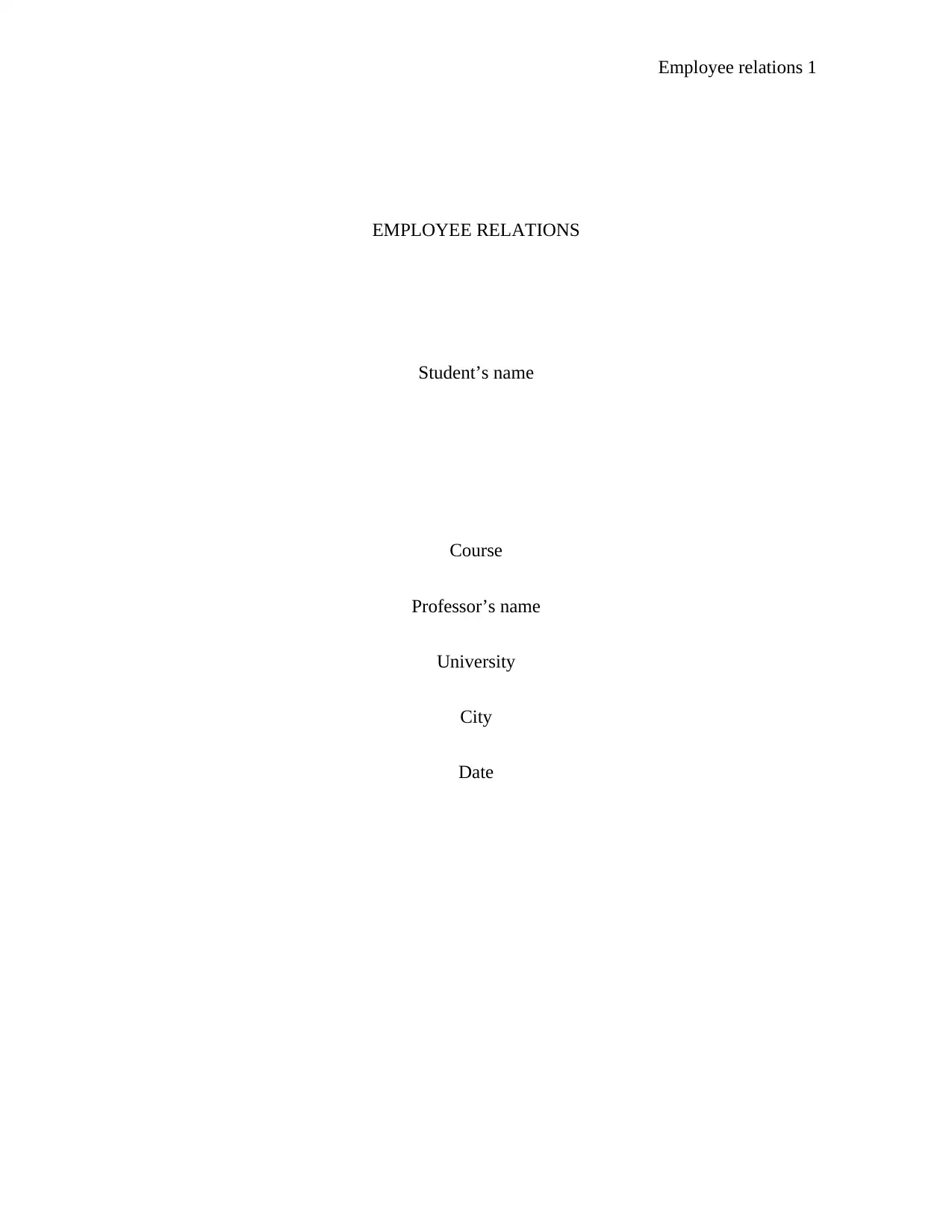
Employee relations 1
EMPLOYEE RELATIONS
Student’s name
Course
Professor’s name
University
City
Date
EMPLOYEE RELATIONS
Student’s name
Course
Professor’s name
University
City
Date
Paraphrase This Document
Need a fresh take? Get an instant paraphrase of this document with our AI Paraphraser
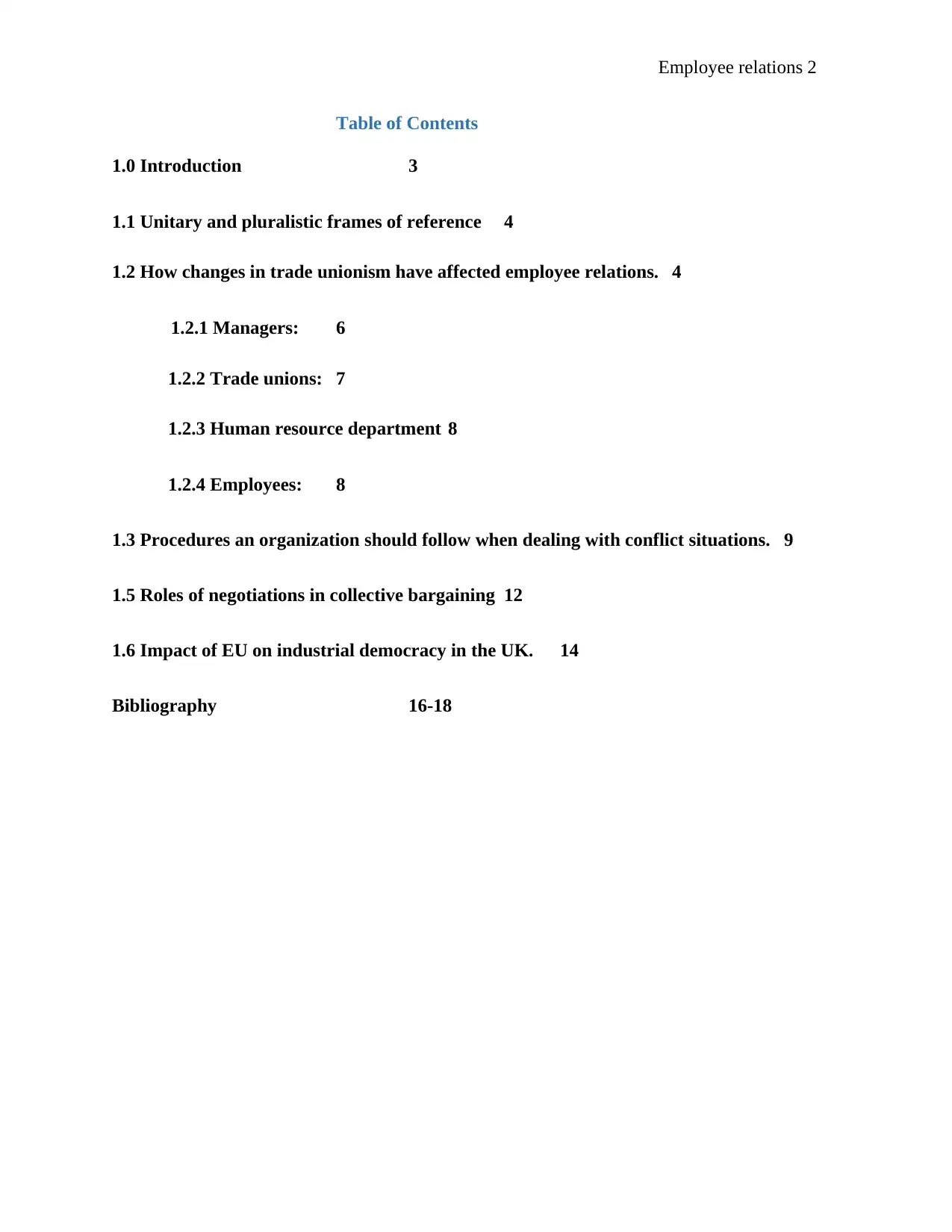
Employee relations 2
Table of Contents
1.0 Introduction 3
1.1 Unitary and pluralistic frames of reference 4
1.2 How changes in trade unionism have affected employee relations. 4
1.2.1 Managers: 6
1.2.2 Trade unions: 7
1.2.3 Human resource department 8
1.2.4 Employees: 8
1.3 Procedures an organization should follow when dealing with conflict situations. 9
1.5 Roles of negotiations in collective bargaining 12
1.6 Impact of EU on industrial democracy in the UK. 14
Bibliography 16-18
Table of Contents
1.0 Introduction 3
1.1 Unitary and pluralistic frames of reference 4
1.2 How changes in trade unionism have affected employee relations. 4
1.2.1 Managers: 6
1.2.2 Trade unions: 7
1.2.3 Human resource department 8
1.2.4 Employees: 8
1.3 Procedures an organization should follow when dealing with conflict situations. 9
1.5 Roles of negotiations in collective bargaining 12
1.6 Impact of EU on industrial democracy in the UK. 14
Bibliography 16-18
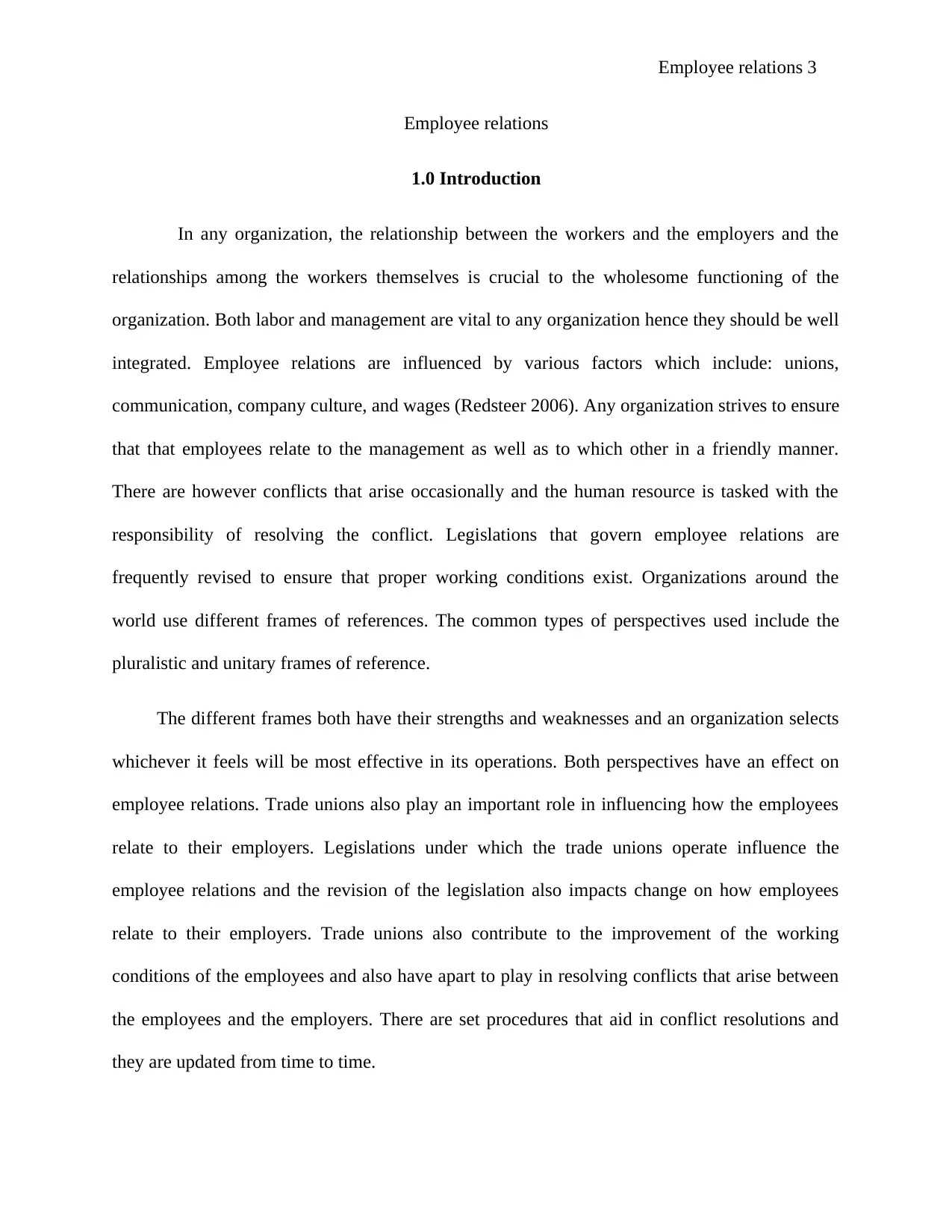
Employee relations 3
Employee relations
1.0 Introduction
In any organization, the relationship between the workers and the employers and the
relationships among the workers themselves is crucial to the wholesome functioning of the
organization. Both labor and management are vital to any organization hence they should be well
integrated. Employee relations are influenced by various factors which include: unions,
communication, company culture, and wages (Redsteer 2006). Any organization strives to ensure
that that employees relate to the management as well as to which other in a friendly manner.
There are however conflicts that arise occasionally and the human resource is tasked with the
responsibility of resolving the conflict. Legislations that govern employee relations are
frequently revised to ensure that proper working conditions exist. Organizations around the
world use different frames of references. The common types of perspectives used include the
pluralistic and unitary frames of reference.
The different frames both have their strengths and weaknesses and an organization selects
whichever it feels will be most effective in its operations. Both perspectives have an effect on
employee relations. Trade unions also play an important role in influencing how the employees
relate to their employers. Legislations under which the trade unions operate influence the
employee relations and the revision of the legislation also impacts change on how employees
relate to their employers. Trade unions also contribute to the improvement of the working
conditions of the employees and also have apart to play in resolving conflicts that arise between
the employees and the employers. There are set procedures that aid in conflict resolutions and
they are updated from time to time.
Employee relations
1.0 Introduction
In any organization, the relationship between the workers and the employers and the
relationships among the workers themselves is crucial to the wholesome functioning of the
organization. Both labor and management are vital to any organization hence they should be well
integrated. Employee relations are influenced by various factors which include: unions,
communication, company culture, and wages (Redsteer 2006). Any organization strives to ensure
that that employees relate to the management as well as to which other in a friendly manner.
There are however conflicts that arise occasionally and the human resource is tasked with the
responsibility of resolving the conflict. Legislations that govern employee relations are
frequently revised to ensure that proper working conditions exist. Organizations around the
world use different frames of references. The common types of perspectives used include the
pluralistic and unitary frames of reference.
The different frames both have their strengths and weaknesses and an organization selects
whichever it feels will be most effective in its operations. Both perspectives have an effect on
employee relations. Trade unions also play an important role in influencing how the employees
relate to their employers. Legislations under which the trade unions operate influence the
employee relations and the revision of the legislation also impacts change on how employees
relate to their employers. Trade unions also contribute to the improvement of the working
conditions of the employees and also have apart to play in resolving conflicts that arise between
the employees and the employers. There are set procedures that aid in conflict resolutions and
they are updated from time to time.
⊘ This is a preview!⊘
Do you want full access?
Subscribe today to unlock all pages.

Trusted by 1+ million students worldwide
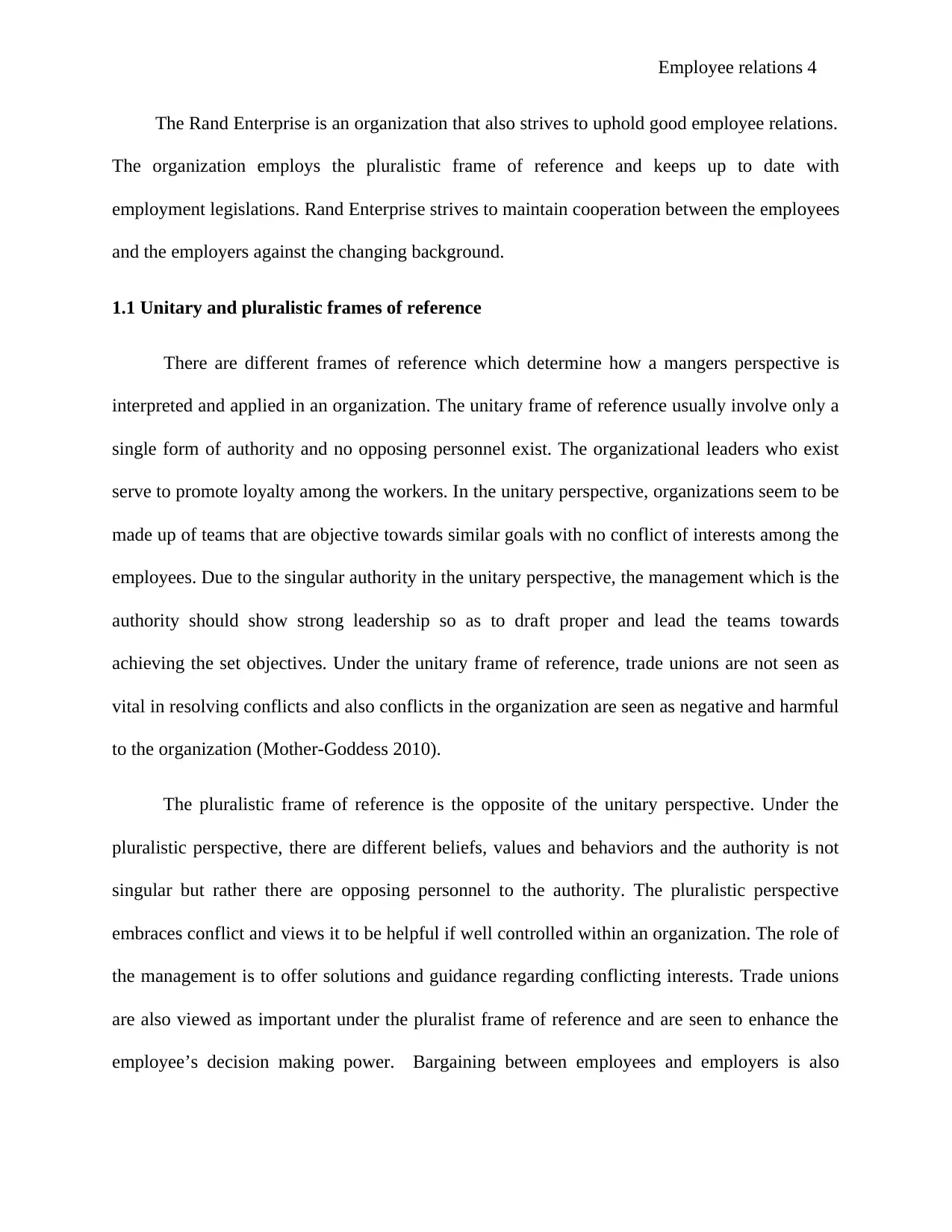
Employee relations 4
The Rand Enterprise is an organization that also strives to uphold good employee relations.
The organization employs the pluralistic frame of reference and keeps up to date with
employment legislations. Rand Enterprise strives to maintain cooperation between the employees
and the employers against the changing background.
1.1 Unitary and pluralistic frames of reference
There are different frames of reference which determine how a mangers perspective is
interpreted and applied in an organization. The unitary frame of reference usually involve only a
single form of authority and no opposing personnel exist. The organizational leaders who exist
serve to promote loyalty among the workers. In the unitary perspective, organizations seem to be
made up of teams that are objective towards similar goals with no conflict of interests among the
employees. Due to the singular authority in the unitary perspective, the management which is the
authority should show strong leadership so as to draft proper and lead the teams towards
achieving the set objectives. Under the unitary frame of reference, trade unions are not seen as
vital in resolving conflicts and also conflicts in the organization are seen as negative and harmful
to the organization (Mother-Goddess 2010).
The pluralistic frame of reference is the opposite of the unitary perspective. Under the
pluralistic perspective, there are different beliefs, values and behaviors and the authority is not
singular but rather there are opposing personnel to the authority. The pluralistic perspective
embraces conflict and views it to be helpful if well controlled within an organization. The role of
the management is to offer solutions and guidance regarding conflicting interests. Trade unions
are also viewed as important under the pluralist frame of reference and are seen to enhance the
employee’s decision making power. Bargaining between employees and employers is also
The Rand Enterprise is an organization that also strives to uphold good employee relations.
The organization employs the pluralistic frame of reference and keeps up to date with
employment legislations. Rand Enterprise strives to maintain cooperation between the employees
and the employers against the changing background.
1.1 Unitary and pluralistic frames of reference
There are different frames of reference which determine how a mangers perspective is
interpreted and applied in an organization. The unitary frame of reference usually involve only a
single form of authority and no opposing personnel exist. The organizational leaders who exist
serve to promote loyalty among the workers. In the unitary perspective, organizations seem to be
made up of teams that are objective towards similar goals with no conflict of interests among the
employees. Due to the singular authority in the unitary perspective, the management which is the
authority should show strong leadership so as to draft proper and lead the teams towards
achieving the set objectives. Under the unitary frame of reference, trade unions are not seen as
vital in resolving conflicts and also conflicts in the organization are seen as negative and harmful
to the organization (Mother-Goddess 2010).
The pluralistic frame of reference is the opposite of the unitary perspective. Under the
pluralistic perspective, there are different beliefs, values and behaviors and the authority is not
singular but rather there are opposing personnel to the authority. The pluralistic perspective
embraces conflict and views it to be helpful if well controlled within an organization. The role of
the management is to offer solutions and guidance regarding conflicting interests. Trade unions
are also viewed as important under the pluralist frame of reference and are seen to enhance the
employee’s decision making power. Bargaining between employees and employers is also
Paraphrase This Document
Need a fresh take? Get an instant paraphrase of this document with our AI Paraphraser
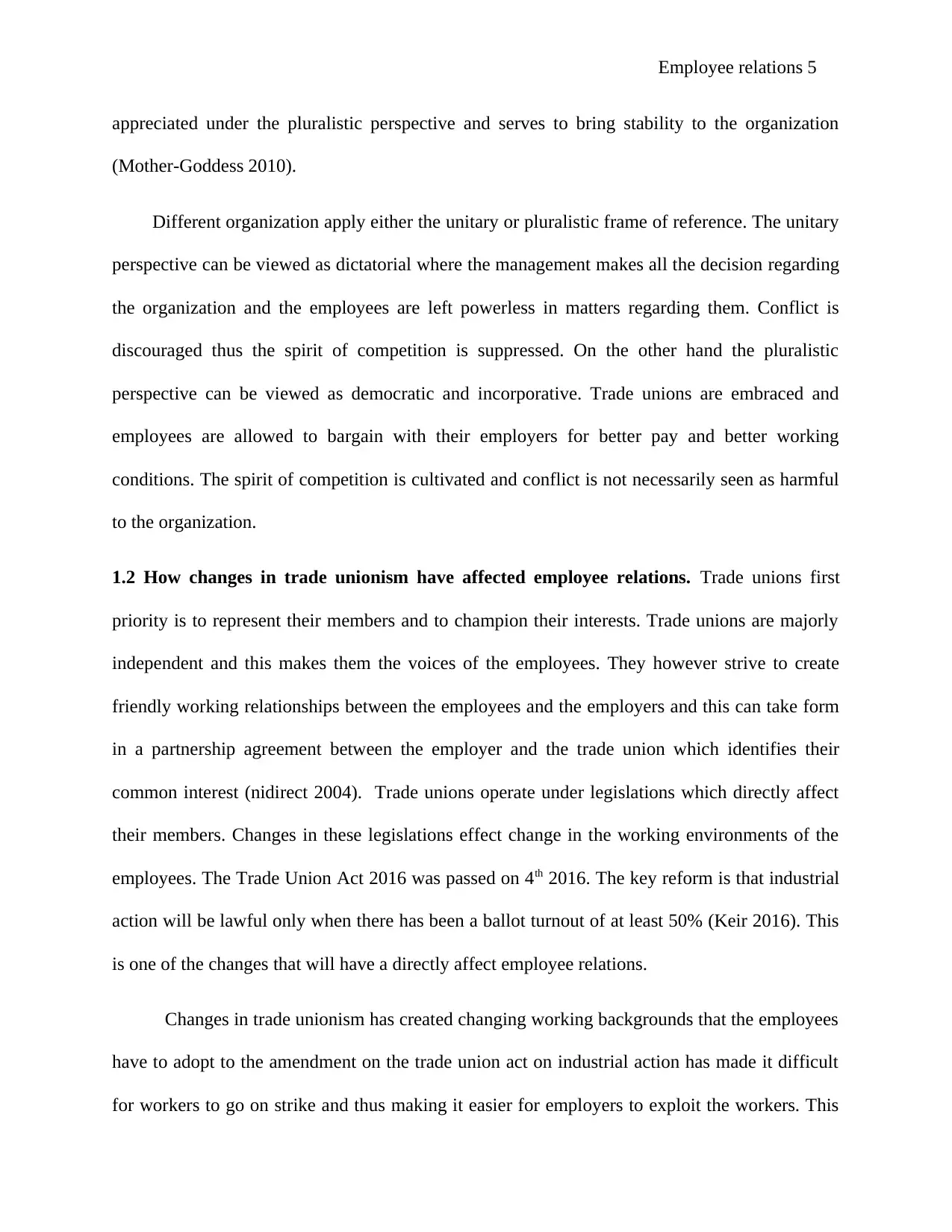
Employee relations 5
appreciated under the pluralistic perspective and serves to bring stability to the organization
(Mother-Goddess 2010).
Different organization apply either the unitary or pluralistic frame of reference. The unitary
perspective can be viewed as dictatorial where the management makes all the decision regarding
the organization and the employees are left powerless in matters regarding them. Conflict is
discouraged thus the spirit of competition is suppressed. On the other hand the pluralistic
perspective can be viewed as democratic and incorporative. Trade unions are embraced and
employees are allowed to bargain with their employers for better pay and better working
conditions. The spirit of competition is cultivated and conflict is not necessarily seen as harmful
to the organization.
1.2 How changes in trade unionism have affected employee relations. Trade unions first
priority is to represent their members and to champion their interests. Trade unions are majorly
independent and this makes them the voices of the employees. They however strive to create
friendly working relationships between the employees and the employers and this can take form
in a partnership agreement between the employer and the trade union which identifies their
common interest (nidirect 2004). Trade unions operate under legislations which directly affect
their members. Changes in these legislations effect change in the working environments of the
employees. The Trade Union Act 2016 was passed on 4th 2016. The key reform is that industrial
action will be lawful only when there has been a ballot turnout of at least 50% (Keir 2016). This
is one of the changes that will have a directly affect employee relations.
Changes in trade unionism has created changing working backgrounds that the employees
have to adopt to the amendment on the trade union act on industrial action has made it difficult
for workers to go on strike and thus making it easier for employers to exploit the workers. This
appreciated under the pluralistic perspective and serves to bring stability to the organization
(Mother-Goddess 2010).
Different organization apply either the unitary or pluralistic frame of reference. The unitary
perspective can be viewed as dictatorial where the management makes all the decision regarding
the organization and the employees are left powerless in matters regarding them. Conflict is
discouraged thus the spirit of competition is suppressed. On the other hand the pluralistic
perspective can be viewed as democratic and incorporative. Trade unions are embraced and
employees are allowed to bargain with their employers for better pay and better working
conditions. The spirit of competition is cultivated and conflict is not necessarily seen as harmful
to the organization.
1.2 How changes in trade unionism have affected employee relations. Trade unions first
priority is to represent their members and to champion their interests. Trade unions are majorly
independent and this makes them the voices of the employees. They however strive to create
friendly working relationships between the employees and the employers and this can take form
in a partnership agreement between the employer and the trade union which identifies their
common interest (nidirect 2004). Trade unions operate under legislations which directly affect
their members. Changes in these legislations effect change in the working environments of the
employees. The Trade Union Act 2016 was passed on 4th 2016. The key reform is that industrial
action will be lawful only when there has been a ballot turnout of at least 50% (Keir 2016). This
is one of the changes that will have a directly affect employee relations.
Changes in trade unionism has created changing working backgrounds that the employees
have to adopt to the amendment on the trade union act on industrial action has made it difficult
for workers to go on strike and thus making it easier for employers to exploit the workers. This
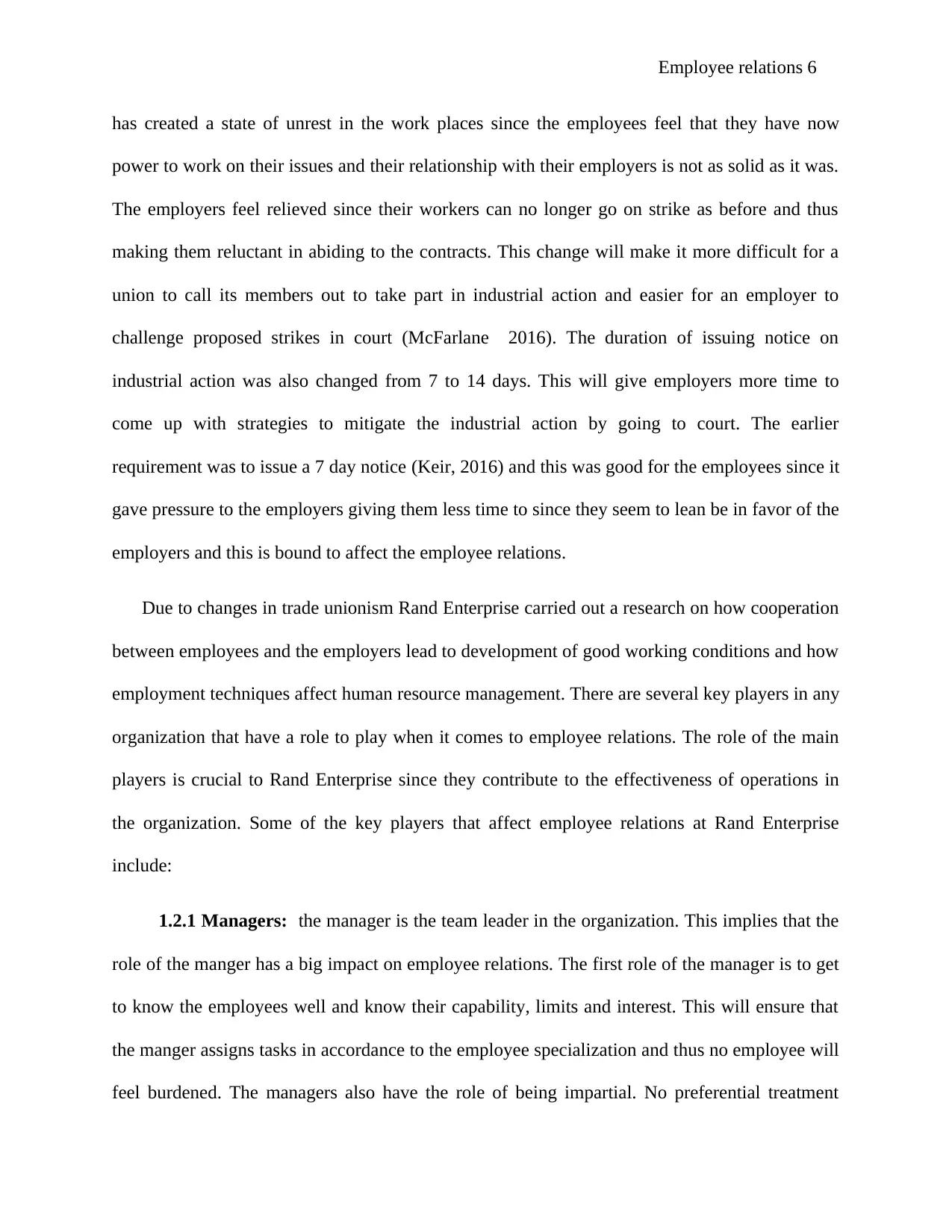
Employee relations 6
has created a state of unrest in the work places since the employees feel that they have now
power to work on their issues and their relationship with their employers is not as solid as it was.
The employers feel relieved since their workers can no longer go on strike as before and thus
making them reluctant in abiding to the contracts. This change will make it more difficult for a
union to call its members out to take part in industrial action and easier for an employer to
challenge proposed strikes in court (McFarlane 2016). The duration of issuing notice on
industrial action was also changed from 7 to 14 days. This will give employers more time to
come up with strategies to mitigate the industrial action by going to court. The earlier
requirement was to issue a 7 day notice (Keir, 2016) and this was good for the employees since it
gave pressure to the employers giving them less time to since they seem to lean be in favor of the
employers and this is bound to affect the employee relations.
Due to changes in trade unionism Rand Enterprise carried out a research on how cooperation
between employees and the employers lead to development of good working conditions and how
employment techniques affect human resource management. There are several key players in any
organization that have a role to play when it comes to employee relations. The role of the main
players is crucial to Rand Enterprise since they contribute to the effectiveness of operations in
the organization. Some of the key players that affect employee relations at Rand Enterprise
include:
1.2.1 Managers: the manager is the team leader in the organization. This implies that the
role of the manger has a big impact on employee relations. The first role of the manager is to get
to know the employees well and know their capability, limits and interest. This will ensure that
the manger assigns tasks in accordance to the employee specialization and thus no employee will
feel burdened. The managers also have the role of being impartial. No preferential treatment
has created a state of unrest in the work places since the employees feel that they have now
power to work on their issues and their relationship with their employers is not as solid as it was.
The employers feel relieved since their workers can no longer go on strike as before and thus
making them reluctant in abiding to the contracts. This change will make it more difficult for a
union to call its members out to take part in industrial action and easier for an employer to
challenge proposed strikes in court (McFarlane 2016). The duration of issuing notice on
industrial action was also changed from 7 to 14 days. This will give employers more time to
come up with strategies to mitigate the industrial action by going to court. The earlier
requirement was to issue a 7 day notice (Keir, 2016) and this was good for the employees since it
gave pressure to the employers giving them less time to since they seem to lean be in favor of the
employers and this is bound to affect the employee relations.
Due to changes in trade unionism Rand Enterprise carried out a research on how cooperation
between employees and the employers lead to development of good working conditions and how
employment techniques affect human resource management. There are several key players in any
organization that have a role to play when it comes to employee relations. The role of the main
players is crucial to Rand Enterprise since they contribute to the effectiveness of operations in
the organization. Some of the key players that affect employee relations at Rand Enterprise
include:
1.2.1 Managers: the manager is the team leader in the organization. This implies that the
role of the manger has a big impact on employee relations. The first role of the manager is to get
to know the employees well and know their capability, limits and interest. This will ensure that
the manger assigns tasks in accordance to the employee specialization and thus no employee will
feel burdened. The managers also have the role of being impartial. No preferential treatment
⊘ This is a preview!⊘
Do you want full access?
Subscribe today to unlock all pages.

Trusted by 1+ million students worldwide
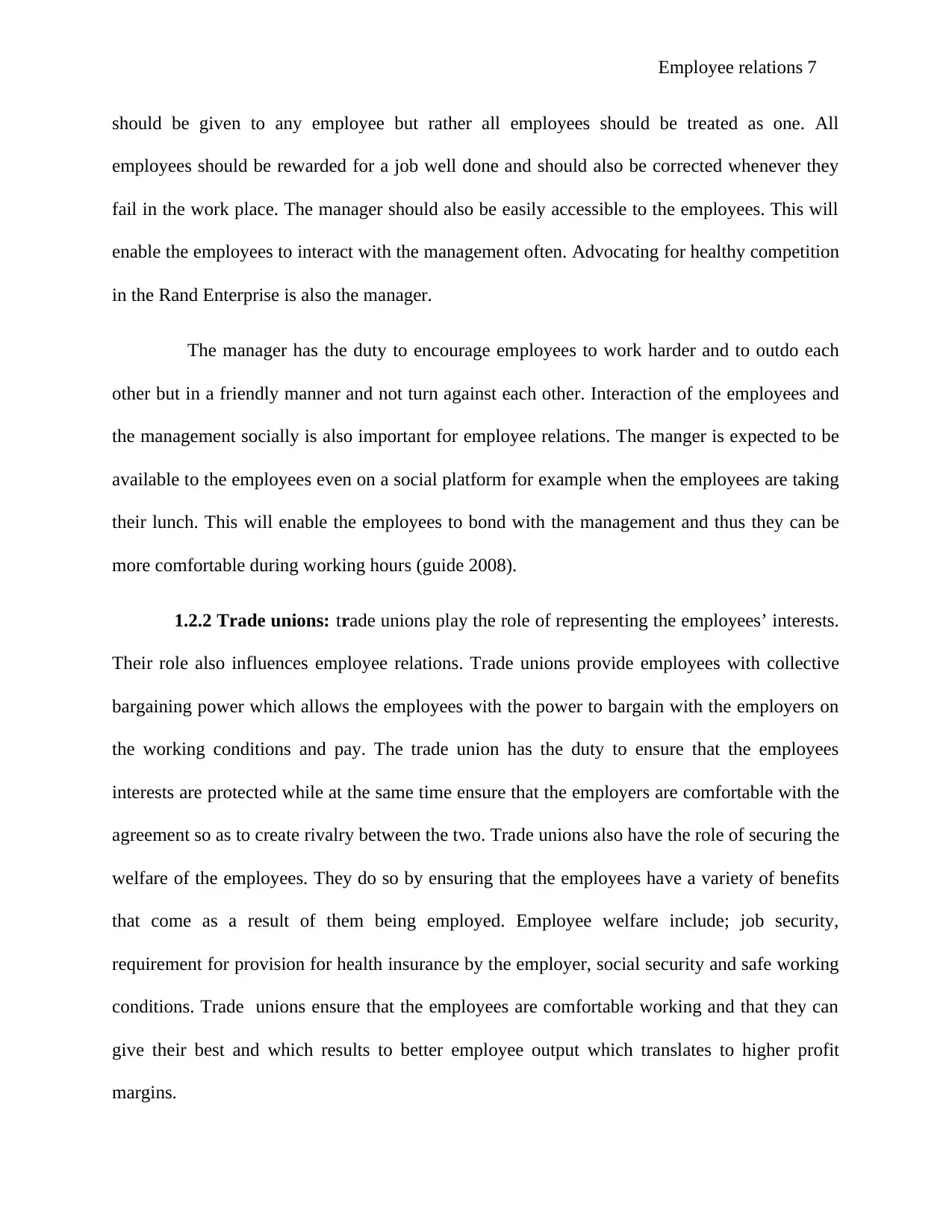
Employee relations 7
should be given to any employee but rather all employees should be treated as one. All
employees should be rewarded for a job well done and should also be corrected whenever they
fail in the work place. The manager should also be easily accessible to the employees. This will
enable the employees to interact with the management often. Advocating for healthy competition
in the Rand Enterprise is also the manager.
The manager has the duty to encourage employees to work harder and to outdo each
other but in a friendly manner and not turn against each other. Interaction of the employees and
the management socially is also important for employee relations. The manger is expected to be
available to the employees even on a social platform for example when the employees are taking
their lunch. This will enable the employees to bond with the management and thus they can be
more comfortable during working hours (guide 2008).
1.2.2 Trade unions: trade unions play the role of representing the employees’ interests.
Their role also influences employee relations. Trade unions provide employees with collective
bargaining power which allows the employees with the power to bargain with the employers on
the working conditions and pay. The trade union has the duty to ensure that the employees
interests are protected while at the same time ensure that the employers are comfortable with the
agreement so as to create rivalry between the two. Trade unions also have the role of securing the
welfare of the employees. They do so by ensuring that the employees have a variety of benefits
that come as a result of them being employed. Employee welfare include; job security,
requirement for provision for health insurance by the employer, social security and safe working
conditions. Trade unions ensure that the employees are comfortable working and that they can
give their best and which results to better employee output which translates to higher profit
margins.
should be given to any employee but rather all employees should be treated as one. All
employees should be rewarded for a job well done and should also be corrected whenever they
fail in the work place. The manager should also be easily accessible to the employees. This will
enable the employees to interact with the management often. Advocating for healthy competition
in the Rand Enterprise is also the manager.
The manager has the duty to encourage employees to work harder and to outdo each
other but in a friendly manner and not turn against each other. Interaction of the employees and
the management socially is also important for employee relations. The manger is expected to be
available to the employees even on a social platform for example when the employees are taking
their lunch. This will enable the employees to bond with the management and thus they can be
more comfortable during working hours (guide 2008).
1.2.2 Trade unions: trade unions play the role of representing the employees’ interests.
Their role also influences employee relations. Trade unions provide employees with collective
bargaining power which allows the employees with the power to bargain with the employers on
the working conditions and pay. The trade union has the duty to ensure that the employees
interests are protected while at the same time ensure that the employers are comfortable with the
agreement so as to create rivalry between the two. Trade unions also have the role of securing the
welfare of the employees. They do so by ensuring that the employees have a variety of benefits
that come as a result of them being employed. Employee welfare include; job security,
requirement for provision for health insurance by the employer, social security and safe working
conditions. Trade unions ensure that the employees are comfortable working and that they can
give their best and which results to better employee output which translates to higher profit
margins.
Paraphrase This Document
Need a fresh take? Get an instant paraphrase of this document with our AI Paraphraser
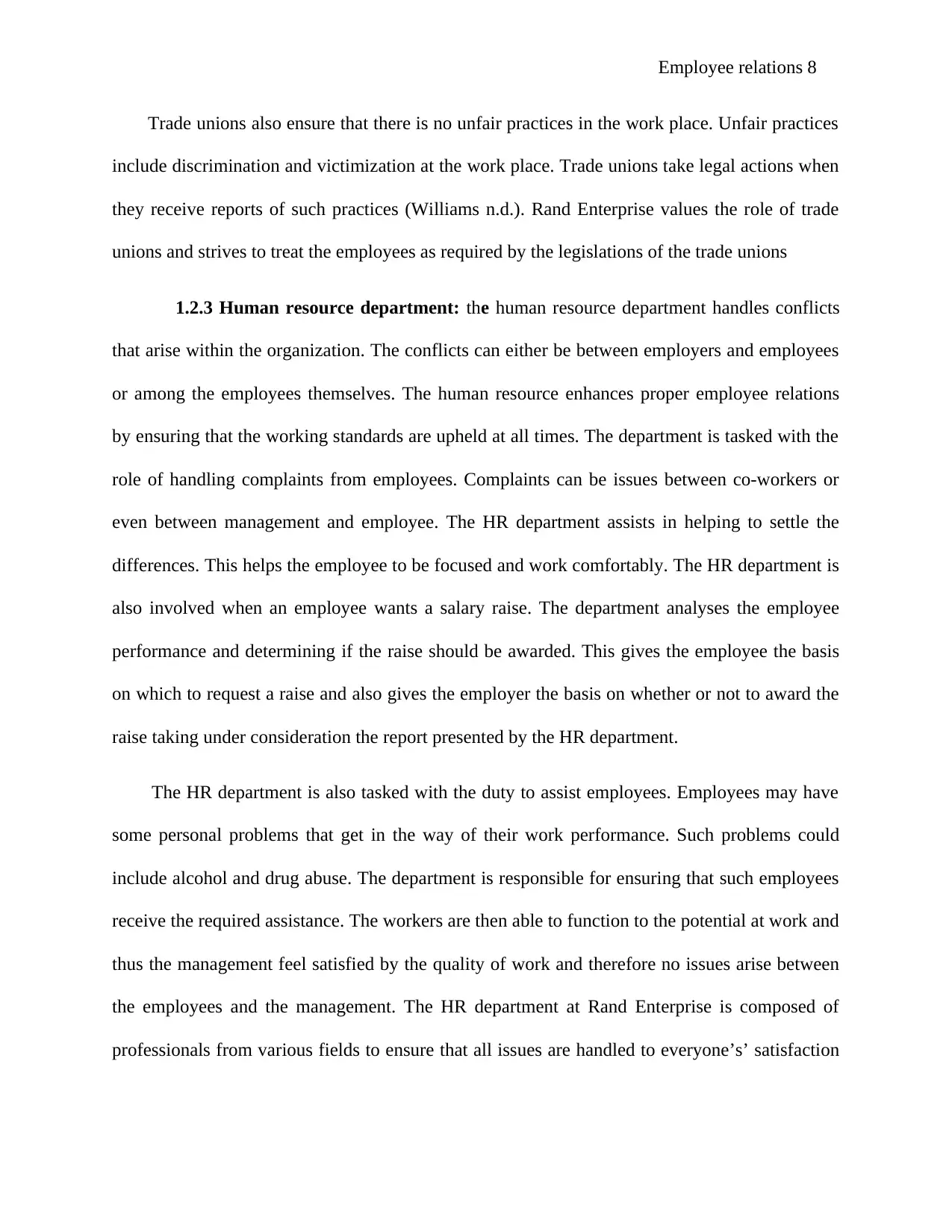
Employee relations 8
Trade unions also ensure that there is no unfair practices in the work place. Unfair practices
include discrimination and victimization at the work place. Trade unions take legal actions when
they receive reports of such practices (Williams n.d.). Rand Enterprise values the role of trade
unions and strives to treat the employees as required by the legislations of the trade unions
1.2.3 Human resource department: the human resource department handles conflicts
that arise within the organization. The conflicts can either be between employers and employees
or among the employees themselves. The human resource enhances proper employee relations
by ensuring that the working standards are upheld at all times. The department is tasked with the
role of handling complaints from employees. Complaints can be issues between co-workers or
even between management and employee. The HR department assists in helping to settle the
differences. This helps the employee to be focused and work comfortably. The HR department is
also involved when an employee wants a salary raise. The department analyses the employee
performance and determining if the raise should be awarded. This gives the employee the basis
on which to request a raise and also gives the employer the basis on whether or not to award the
raise taking under consideration the report presented by the HR department.
The HR department is also tasked with the duty to assist employees. Employees may have
some personal problems that get in the way of their work performance. Such problems could
include alcohol and drug abuse. The department is responsible for ensuring that such employees
receive the required assistance. The workers are then able to function to the potential at work and
thus the management feel satisfied by the quality of work and therefore no issues arise between
the employees and the management. The HR department at Rand Enterprise is composed of
professionals from various fields to ensure that all issues are handled to everyone’s’ satisfaction
Trade unions also ensure that there is no unfair practices in the work place. Unfair practices
include discrimination and victimization at the work place. Trade unions take legal actions when
they receive reports of such practices (Williams n.d.). Rand Enterprise values the role of trade
unions and strives to treat the employees as required by the legislations of the trade unions
1.2.3 Human resource department: the human resource department handles conflicts
that arise within the organization. The conflicts can either be between employers and employees
or among the employees themselves. The human resource enhances proper employee relations
by ensuring that the working standards are upheld at all times. The department is tasked with the
role of handling complaints from employees. Complaints can be issues between co-workers or
even between management and employee. The HR department assists in helping to settle the
differences. This helps the employee to be focused and work comfortably. The HR department is
also involved when an employee wants a salary raise. The department analyses the employee
performance and determining if the raise should be awarded. This gives the employee the basis
on which to request a raise and also gives the employer the basis on whether or not to award the
raise taking under consideration the report presented by the HR department.
The HR department is also tasked with the duty to assist employees. Employees may have
some personal problems that get in the way of their work performance. Such problems could
include alcohol and drug abuse. The department is responsible for ensuring that such employees
receive the required assistance. The workers are then able to function to the potential at work and
thus the management feel satisfied by the quality of work and therefore no issues arise between
the employees and the management. The HR department at Rand Enterprise is composed of
professionals from various fields to ensure that all issues are handled to everyone’s’ satisfaction
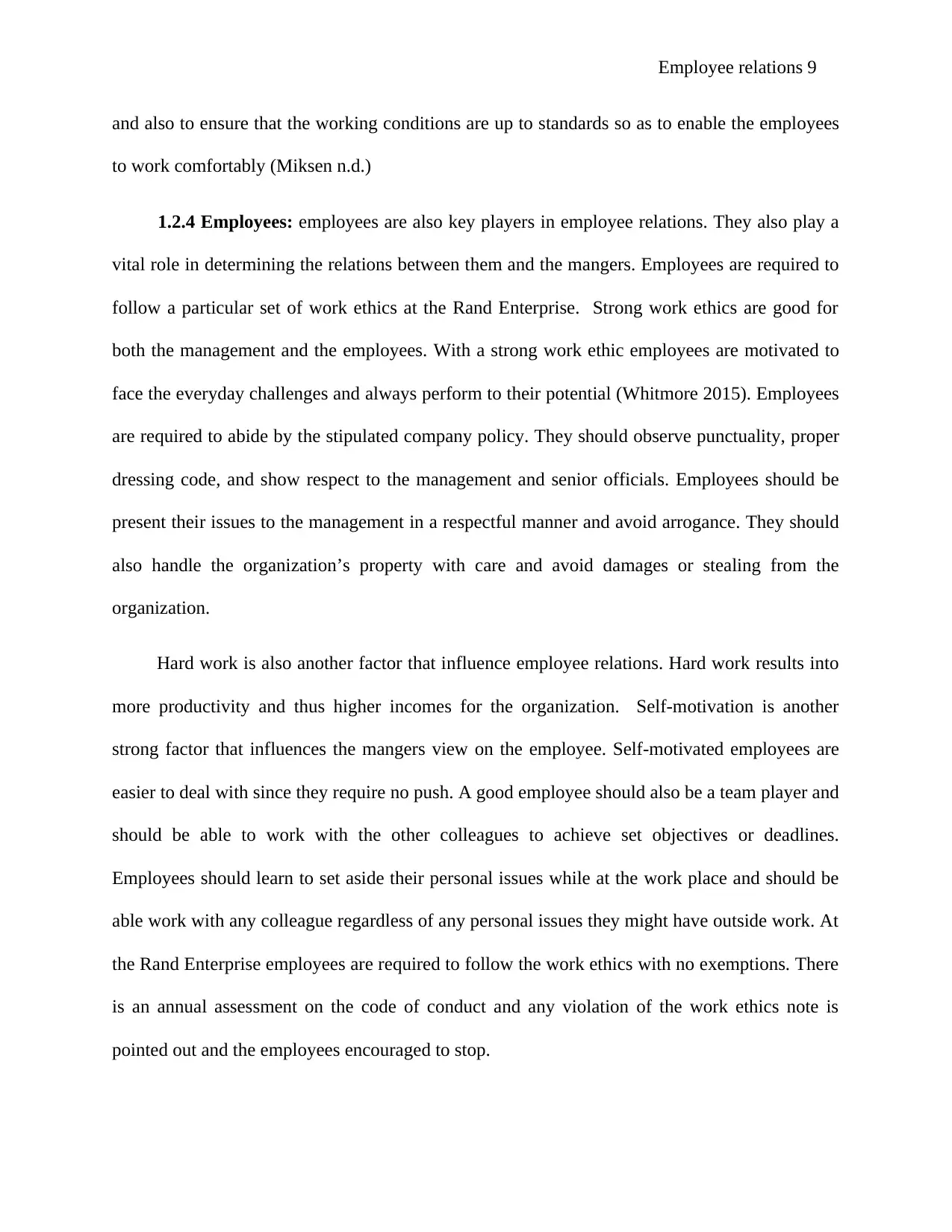
Employee relations 9
and also to ensure that the working conditions are up to standards so as to enable the employees
to work comfortably (Miksen n.d.)
1.2.4 Employees: employees are also key players in employee relations. They also play a
vital role in determining the relations between them and the mangers. Employees are required to
follow a particular set of work ethics at the Rand Enterprise. Strong work ethics are good for
both the management and the employees. With a strong work ethic employees are motivated to
face the everyday challenges and always perform to their potential (Whitmore 2015). Employees
are required to abide by the stipulated company policy. They should observe punctuality, proper
dressing code, and show respect to the management and senior officials. Employees should be
present their issues to the management in a respectful manner and avoid arrogance. They should
also handle the organization’s property with care and avoid damages or stealing from the
organization.
Hard work is also another factor that influence employee relations. Hard work results into
more productivity and thus higher incomes for the organization. Self-motivation is another
strong factor that influences the mangers view on the employee. Self-motivated employees are
easier to deal with since they require no push. A good employee should also be a team player and
should be able to work with the other colleagues to achieve set objectives or deadlines.
Employees should learn to set aside their personal issues while at the work place and should be
able work with any colleague regardless of any personal issues they might have outside work. At
the Rand Enterprise employees are required to follow the work ethics with no exemptions. There
is an annual assessment on the code of conduct and any violation of the work ethics note is
pointed out and the employees encouraged to stop.
and also to ensure that the working conditions are up to standards so as to enable the employees
to work comfortably (Miksen n.d.)
1.2.4 Employees: employees are also key players in employee relations. They also play a
vital role in determining the relations between them and the mangers. Employees are required to
follow a particular set of work ethics at the Rand Enterprise. Strong work ethics are good for
both the management and the employees. With a strong work ethic employees are motivated to
face the everyday challenges and always perform to their potential (Whitmore 2015). Employees
are required to abide by the stipulated company policy. They should observe punctuality, proper
dressing code, and show respect to the management and senior officials. Employees should be
present their issues to the management in a respectful manner and avoid arrogance. They should
also handle the organization’s property with care and avoid damages or stealing from the
organization.
Hard work is also another factor that influence employee relations. Hard work results into
more productivity and thus higher incomes for the organization. Self-motivation is another
strong factor that influences the mangers view on the employee. Self-motivated employees are
easier to deal with since they require no push. A good employee should also be a team player and
should be able to work with the other colleagues to achieve set objectives or deadlines.
Employees should learn to set aside their personal issues while at the work place and should be
able work with any colleague regardless of any personal issues they might have outside work. At
the Rand Enterprise employees are required to follow the work ethics with no exemptions. There
is an annual assessment on the code of conduct and any violation of the work ethics note is
pointed out and the employees encouraged to stop.
⊘ This is a preview!⊘
Do you want full access?
Subscribe today to unlock all pages.

Trusted by 1+ million students worldwide
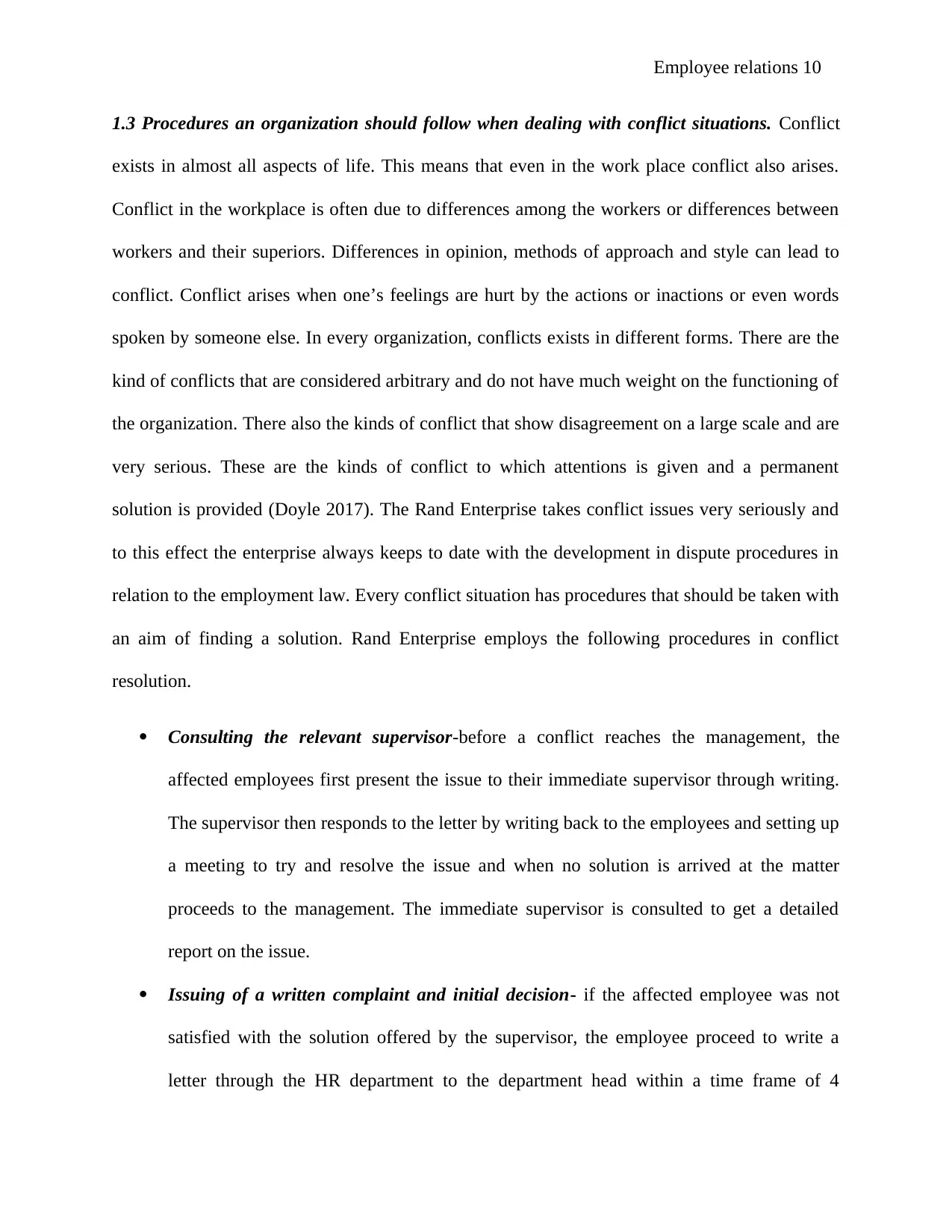
Employee relations 10
1.3 Procedures an organization should follow when dealing with conflict situations. Conflict
exists in almost all aspects of life. This means that even in the work place conflict also arises.
Conflict in the workplace is often due to differences among the workers or differences between
workers and their superiors. Differences in opinion, methods of approach and style can lead to
conflict. Conflict arises when one’s feelings are hurt by the actions or inactions or even words
spoken by someone else. In every organization, conflicts exists in different forms. There are the
kind of conflicts that are considered arbitrary and do not have much weight on the functioning of
the organization. There also the kinds of conflict that show disagreement on a large scale and are
very serious. These are the kinds of conflict to which attentions is given and a permanent
solution is provided (Doyle 2017). The Rand Enterprise takes conflict issues very seriously and
to this effect the enterprise always keeps to date with the development in dispute procedures in
relation to the employment law. Every conflict situation has procedures that should be taken with
an aim of finding a solution. Rand Enterprise employs the following procedures in conflict
resolution.
Consulting the relevant supervisor-before a conflict reaches the management, the
affected employees first present the issue to their immediate supervisor through writing.
The supervisor then responds to the letter by writing back to the employees and setting up
a meeting to try and resolve the issue and when no solution is arrived at the matter
proceeds to the management. The immediate supervisor is consulted to get a detailed
report on the issue.
Issuing of a written complaint and initial decision- if the affected employee was not
satisfied with the solution offered by the supervisor, the employee proceed to write a
letter through the HR department to the department head within a time frame of 4
1.3 Procedures an organization should follow when dealing with conflict situations. Conflict
exists in almost all aspects of life. This means that even in the work place conflict also arises.
Conflict in the workplace is often due to differences among the workers or differences between
workers and their superiors. Differences in opinion, methods of approach and style can lead to
conflict. Conflict arises when one’s feelings are hurt by the actions or inactions or even words
spoken by someone else. In every organization, conflicts exists in different forms. There are the
kind of conflicts that are considered arbitrary and do not have much weight on the functioning of
the organization. There also the kinds of conflict that show disagreement on a large scale and are
very serious. These are the kinds of conflict to which attentions is given and a permanent
solution is provided (Doyle 2017). The Rand Enterprise takes conflict issues very seriously and
to this effect the enterprise always keeps to date with the development in dispute procedures in
relation to the employment law. Every conflict situation has procedures that should be taken with
an aim of finding a solution. Rand Enterprise employs the following procedures in conflict
resolution.
Consulting the relevant supervisor-before a conflict reaches the management, the
affected employees first present the issue to their immediate supervisor through writing.
The supervisor then responds to the letter by writing back to the employees and setting up
a meeting to try and resolve the issue and when no solution is arrived at the matter
proceeds to the management. The immediate supervisor is consulted to get a detailed
report on the issue.
Issuing of a written complaint and initial decision- if the affected employee was not
satisfied with the solution offered by the supervisor, the employee proceed to write a
letter through the HR department to the department head within a time frame of 4
Paraphrase This Document
Need a fresh take? Get an instant paraphrase of this document with our AI Paraphraser
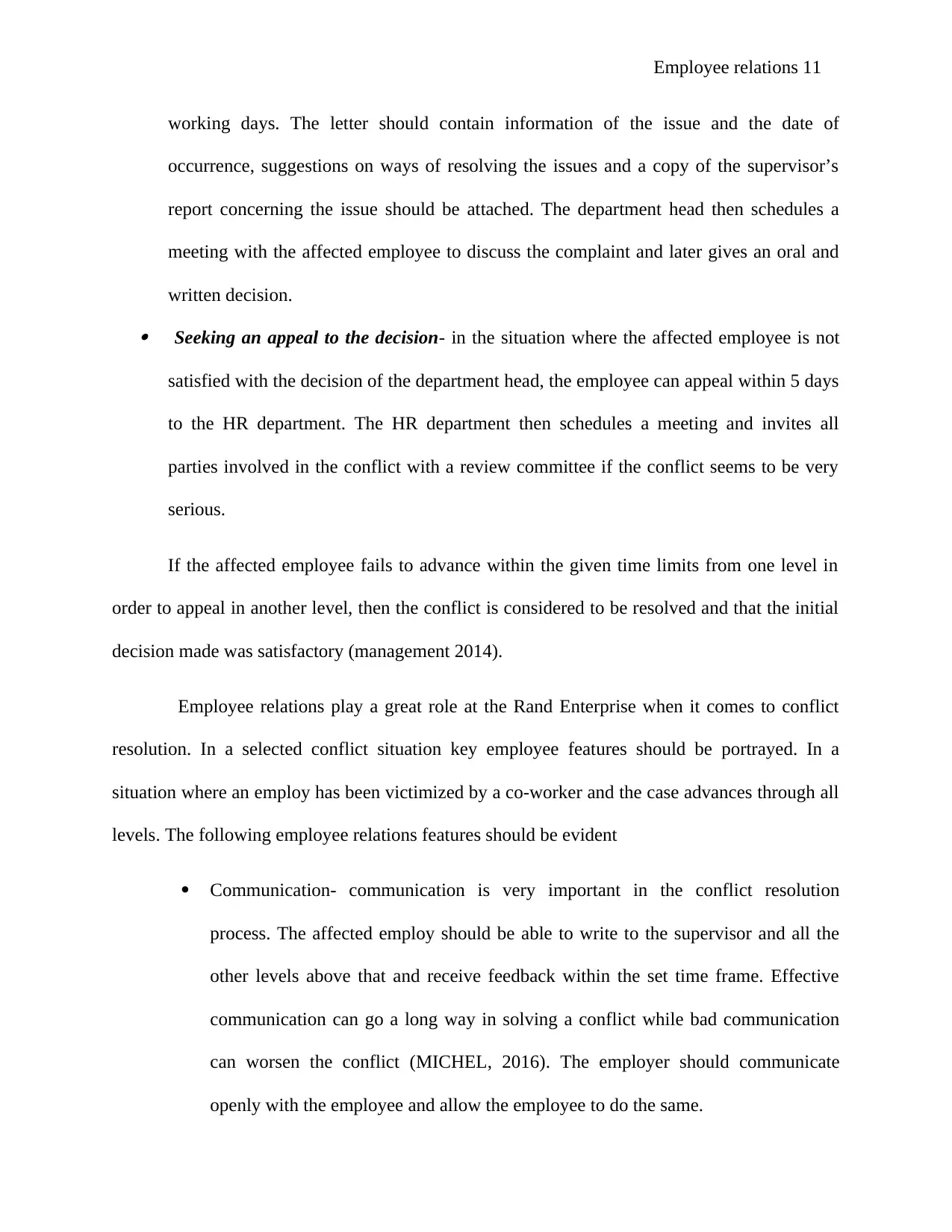
Employee relations 11
working days. The letter should contain information of the issue and the date of
occurrence, suggestions on ways of resolving the issues and a copy of the supervisor’s
report concerning the issue should be attached. The department head then schedules a
meeting with the affected employee to discuss the complaint and later gives an oral and
written decision. Seeking an appeal to the decision- in the situation where the affected employee is not
satisfied with the decision of the department head, the employee can appeal within 5 days
to the HR department. The HR department then schedules a meeting and invites all
parties involved in the conflict with a review committee if the conflict seems to be very
serious.
If the affected employee fails to advance within the given time limits from one level in
order to appeal in another level, then the conflict is considered to be resolved and that the initial
decision made was satisfactory (management 2014).
Employee relations play a great role at the Rand Enterprise when it comes to conflict
resolution. In a selected conflict situation key employee features should be portrayed. In a
situation where an employ has been victimized by a co-worker and the case advances through all
levels. The following employee relations features should be evident
Communication- communication is very important in the conflict resolution
process. The affected employ should be able to write to the supervisor and all the
other levels above that and receive feedback within the set time frame. Effective
communication can go a long way in solving a conflict while bad communication
can worsen the conflict (MICHEL, 2016). The employer should communicate
openly with the employee and allow the employee to do the same.
working days. The letter should contain information of the issue and the date of
occurrence, suggestions on ways of resolving the issues and a copy of the supervisor’s
report concerning the issue should be attached. The department head then schedules a
meeting with the affected employee to discuss the complaint and later gives an oral and
written decision. Seeking an appeal to the decision- in the situation where the affected employee is not
satisfied with the decision of the department head, the employee can appeal within 5 days
to the HR department. The HR department then schedules a meeting and invites all
parties involved in the conflict with a review committee if the conflict seems to be very
serious.
If the affected employee fails to advance within the given time limits from one level in
order to appeal in another level, then the conflict is considered to be resolved and that the initial
decision made was satisfactory (management 2014).
Employee relations play a great role at the Rand Enterprise when it comes to conflict
resolution. In a selected conflict situation key employee features should be portrayed. In a
situation where an employ has been victimized by a co-worker and the case advances through all
levels. The following employee relations features should be evident
Communication- communication is very important in the conflict resolution
process. The affected employ should be able to write to the supervisor and all the
other levels above that and receive feedback within the set time frame. Effective
communication can go a long way in solving a conflict while bad communication
can worsen the conflict (MICHEL, 2016). The employer should communicate
openly with the employee and allow the employee to do the same.
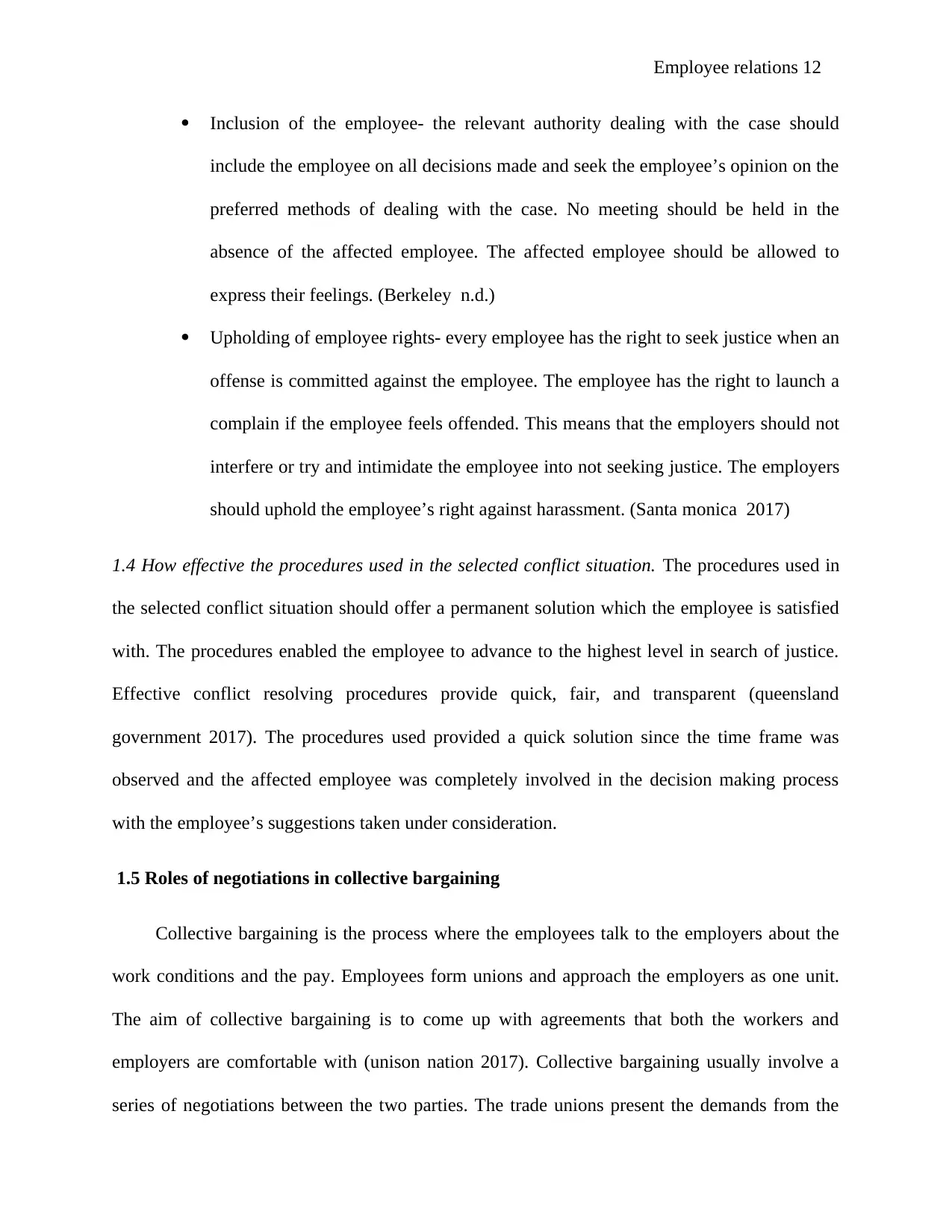
Employee relations 12
Inclusion of the employee- the relevant authority dealing with the case should
include the employee on all decisions made and seek the employee’s opinion on the
preferred methods of dealing with the case. No meeting should be held in the
absence of the affected employee. The affected employee should be allowed to
express their feelings. (Berkeley n.d.)
Upholding of employee rights- every employee has the right to seek justice when an
offense is committed against the employee. The employee has the right to launch a
complain if the employee feels offended. This means that the employers should not
interfere or try and intimidate the employee into not seeking justice. The employers
should uphold the employee’s right against harassment. (Santa monica 2017)
1.4 How effective the procedures used in the selected conflict situation. The procedures used in
the selected conflict situation should offer a permanent solution which the employee is satisfied
with. The procedures enabled the employee to advance to the highest level in search of justice.
Effective conflict resolving procedures provide quick, fair, and transparent (queensland
government 2017). The procedures used provided a quick solution since the time frame was
observed and the affected employee was completely involved in the decision making process
with the employee’s suggestions taken under consideration.
1.5 Roles of negotiations in collective bargaining
Collective bargaining is the process where the employees talk to the employers about the
work conditions and the pay. Employees form unions and approach the employers as one unit.
The aim of collective bargaining is to come up with agreements that both the workers and
employers are comfortable with (unison nation 2017). Collective bargaining usually involve a
series of negotiations between the two parties. The trade unions present the demands from the
Inclusion of the employee- the relevant authority dealing with the case should
include the employee on all decisions made and seek the employee’s opinion on the
preferred methods of dealing with the case. No meeting should be held in the
absence of the affected employee. The affected employee should be allowed to
express their feelings. (Berkeley n.d.)
Upholding of employee rights- every employee has the right to seek justice when an
offense is committed against the employee. The employee has the right to launch a
complain if the employee feels offended. This means that the employers should not
interfere or try and intimidate the employee into not seeking justice. The employers
should uphold the employee’s right against harassment. (Santa monica 2017)
1.4 How effective the procedures used in the selected conflict situation. The procedures used in
the selected conflict situation should offer a permanent solution which the employee is satisfied
with. The procedures enabled the employee to advance to the highest level in search of justice.
Effective conflict resolving procedures provide quick, fair, and transparent (queensland
government 2017). The procedures used provided a quick solution since the time frame was
observed and the affected employee was completely involved in the decision making process
with the employee’s suggestions taken under consideration.
1.5 Roles of negotiations in collective bargaining
Collective bargaining is the process where the employees talk to the employers about the
work conditions and the pay. Employees form unions and approach the employers as one unit.
The aim of collective bargaining is to come up with agreements that both the workers and
employers are comfortable with (unison nation 2017). Collective bargaining usually involve a
series of negotiations between the two parties. The trade unions present the demands from the
⊘ This is a preview!⊘
Do you want full access?
Subscribe today to unlock all pages.

Trusted by 1+ million students worldwide
1 out of 19
Related Documents
Your All-in-One AI-Powered Toolkit for Academic Success.
+13062052269
info@desklib.com
Available 24*7 on WhatsApp / Email
![[object Object]](/_next/static/media/star-bottom.7253800d.svg)
Unlock your academic potential
Copyright © 2020–2025 A2Z Services. All Rights Reserved. Developed and managed by ZUCOL.





